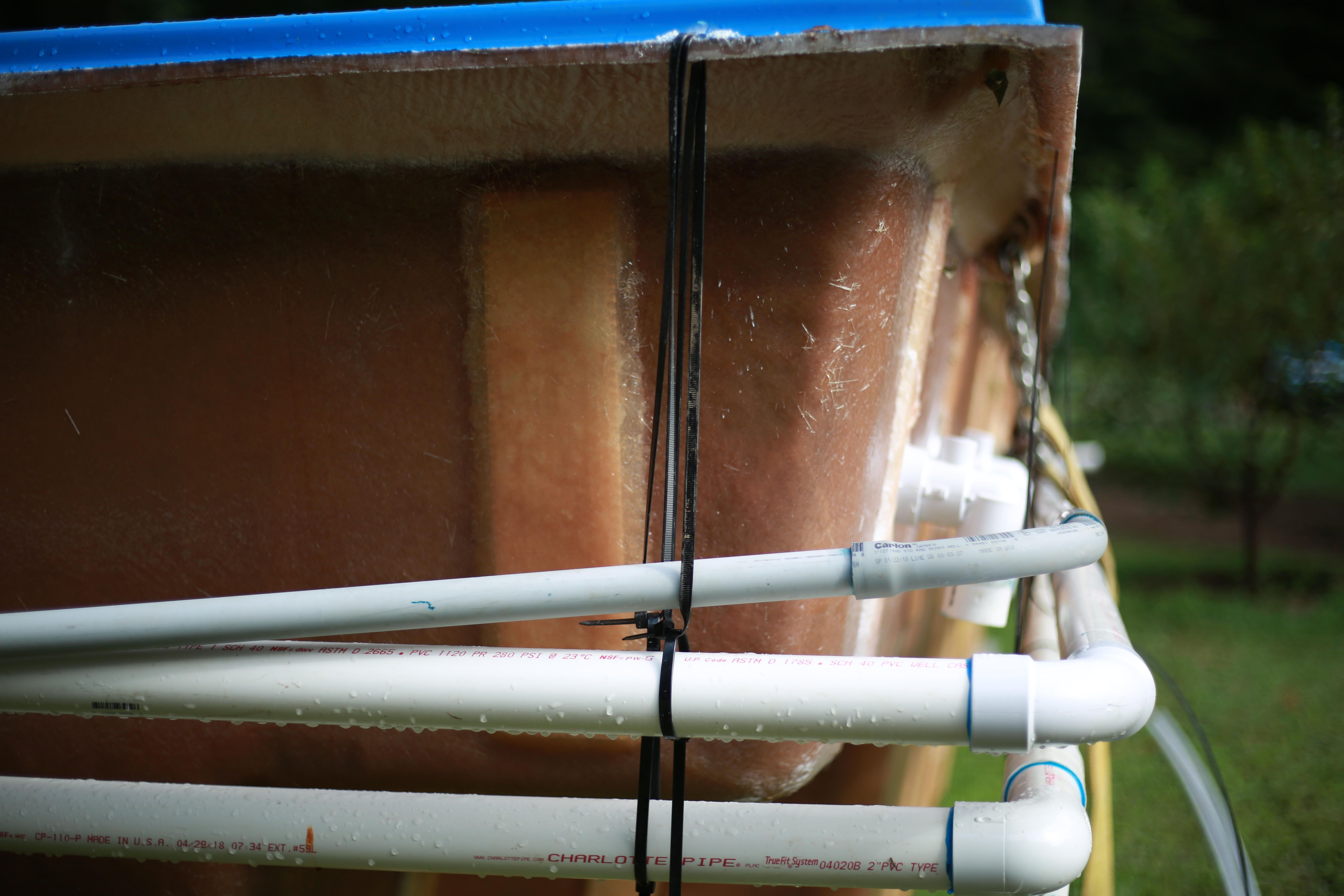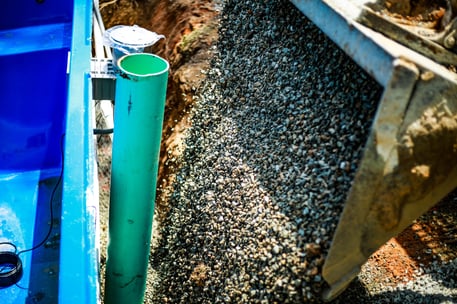5 Keys to Properly Plumbing a Fiberglass Pool (Contractor-Backed Guide)
Updated: September 2nd, 2025 | Published: April 8th, 2019
3 min read
By Jason Hughes

Whether you're a homeowner planning a project or a contractor refining your process, this guide will help you avoid the most common plumbing pitfalls in fiberglass pool installations.
Plumbing may be hidden underground, but when it’s done wrong, the problems rise quickly to the surface—leaks, suction issues, failing pipework, even damage to the pool itself.
After decades of installing fiberglass pools, I’ve seen that most plumbing failures are caused by poor installation, not faulty materials. The good news? These problems are almost always preventable with the right techniques.
In this guide, I’ll walk you through the five most important best practices for fiberglass pool plumbing—drawn from real-world experience in the field.
1. Use Proper Backfill Material
Surprisingly, the first key to strong plumbing has nothing to do with pipes—it’s about what surrounds them.
Most plumbing leaks are caused by shifting backfill, not the plumbing itself.
When backfill settles unevenly, it puts pressure on the pipes and fittings. Over time, this stress can lead to cracks, joint failures, or total collapse.
What is recommend: Use clean, crushed gravel (not sand) as your backfill.
-
Gravel compacts upon placement—no water-assisted “washing” needed
-
Reduces settlement compared to sand (which can sink 12"–18" over time)
-
Applies less pressure to plumbing and through-wall fittings
According to my experience, gravel backfill could eliminate up to 75% of all plumbing-related issues around fiberglass pools.
2. Use Rigid PVC Instead of Flex Pipe.jpg?width=497&height=331&name=02%20Rigid%20PVC%20(1).jpg)
This one tends to generate debate, but here’s my take: rigid PVC is the better long-term choice for inground pool plumbing.
While flexible PVC is easier to install and can bend around corners without fittings, it comes with serious durability risks—especially underground.
Read this full comparison in this article: Rigid vs. Flex PVC Pipe
Here’s what real homeowners have reported:
“My skimmer line flex pipe was riddled with bug chews… we had multiple suction issues.”
“Ants and termites destroyed our flex pipe twice in one season.”
“My installer no longer uses flex pipe at all—it’s just not worth the risk.”
I've heard dozens of these stories, and the pattern is clear: underground flex pipe is more vulnerable to pest damage and long-term failure.
3. Secure the Plumbing to the Pool Structure.jpg?width=447&height=298&name=03%20plumbing%20straps%20(2).jpg)
Even when using gravel as backfill, it’s critical to secure plumbing lines to prevent them from settling or shifting over time.
Here’s how it's done:
-
Drill small holes through the fiberglass coping
-
Run straps or wire through these holes and wrap around the plumbing lines
-
Secure plumbing every 4–5 feet, especially near thru-wall fittings
This method also allows crews to pre-plumb the pool shell before it's set into the ground, saving time and reducing job site complications.
4. Always Pressure-Test Your Plumbing
This one’s straightforward, but it’s too important not to mention.
All plumbing lines should be pressure-tested before backfilling to verify there are no leaks.
This is the final quality check before everything gets buried—and skipping it can lead to expensive do-overs.
5. Heat-Bend Rigid PVC for Smooth Turns
One of the biggest arguments in favor of flex pipe is that it allows smooth directional changes without the need for fittings.
But here’s the good news: you can get the same flexibility with heat-bent rigid PVC—without sacrificing strength.
Why it works:
-
Reduces the number of glued fittings
-
Maintains the structural integrity of rigid pipe
-
Allows for cleaner, more customized plumbing layouts
Watch this tutorial video here: How to Heat-Bend Rigid PVC Pipe
How to Know if Your Pool Builder Uses the Right Plumbing Practices
Here’s what to look for when evaluating a builder’s plumbing process:
Preferred Plumbing and Backfill Standards
-
Crushed gravel backfill (not sand)
-
Schedule 40 rigid PVC (not flex)
-
Strapped plumbing secured to pool shell
-
Heat-bent rigid PVC for clean turns
-
Plumbing encased in stone to prevent shifting
-
12” concrete collar around pool perimeter
-
Sump pipe to monitor and remove groundwater
-
Composite rods "fuse" patio to pool for added structural integrity
See the standards preferred by pool installers all accross the county here: Fiberglass Pool Installation Best Practices
These standards were developed not just to improve performance, but to prevent the most common installation problems before they start.

Final Takeaway
When it comes to plumbing a fiberglass pool, quality isn't just in the materials—it's in the methods.
If you're planning a pool project or vetting a builder, don't be afraid to ask the right questions. A few key decisions during installation can mean the difference between a lifetime of performance—or a season of repairs.
From the Author: Jason Hughes
I wrote this article because I’ve seen firsthand how many pool plumbing issues could have been avoided with a few simple best practices. After more than 20 years in this industry, I want to help homeowners and builders alike avoid the same frustrating (and costly) mistakes. Whether you’re a pool shopper or a fellow installer, I hope this guide gives you a clearer path toward a cleaner, longer-lasting plumbing system.
From the Manufacturer: River Pools
As the manufacturer of fiberglass pools used in installations like the one described here, we strongly support the best practices outlined in this article. They reflect the level of care and attention to detail that leads to better long-term results for homeowners.
We’re committed to educating and empowering both homeowners and installers with information that helps ensure a successful pool project. While we don’t perform installations ourselves, we proudly advocate for high standards like those described above and encourage anyone working with one of our pools to follow proven methods that help avoid common issues.
Jason Hughes is a partner at River Pools Virginia, a fiberglass pool installation company based in Warsaw, Virginia. With over 20 years of hands-on experience, Jason has dedicated his career to helping families create beautiful, functional backyards while ensuring every fiberglass pool installation meets the highest standards of quality and safety. In addition to his work with homeowners, Jason serves as a GENESIS instructor with the Pool & Hot Tub Alliance (PHTA), where he teaches fiberglass pool installation best practices to pool professionals across the country. Whether he’s on a job site or leading a training session, Jason is passionate about raising the bar for fiberglass pool installations and helping families make confident, informed decisions as they transform their outdoor spaces.
Topics:


